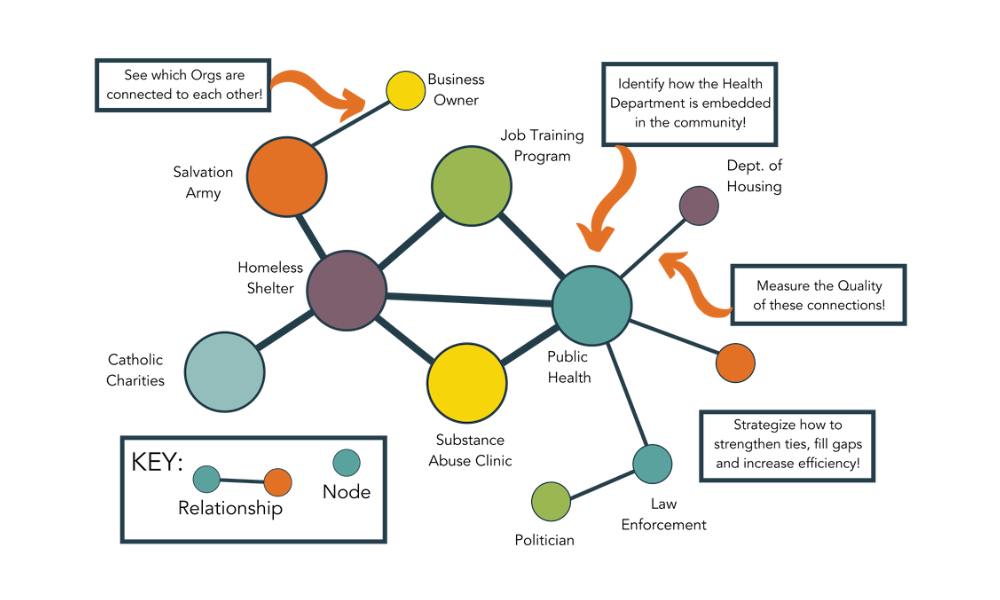In our ever-globalizing world of business and social impact, strategic collaboration and partnership-building are paramount. To navigate these complexities, more and more organizations are turning to network science, a field that delves into complex networks and their interdependencies. Leveraging network strategies drawn from this rich discipline can offer organizations the edge they need to enhance collaboration and build stronger partnerships.
Let’s delve deeper into how these powerful network strategies can fortify your collaboration efforts and transform your partnership-building approach.
Table of Contents
Understanding Network Science Strategies

Whereas traditional strategies in social impact often focus on individual entities or isolated relationships, network science strategies look at the bigger picture—the interconnections and interdependencies within a network. They offer a more holistic view, understanding that the whole is more than just the sum of its parts.
What sets network science strategies apart is their unique emphasis on the network’s overall structure and dynamics. They understand that key nodes, connection diversity, clustering and modularity, reciprocity, short path lengths, redundancy, network dynamics, and the strength of ties all play significant roles in the network’s overall function and effectiveness. By leveraging these unique network aspects, organizations can build more robust, resilient, and impactful collaborations and partnerships.
Now, let’s explore these eight powerful network science strategies in more detail.
I. The Power of Key Nodes
The foundation of any successful network strategy lies in identifying the key nodes. These nodes, be they individuals or organizations, command more influence within the network. They are characterized by a high number of connections, a bridging role between other nodes, or a strong association with other influential nodes. Such key nodes can significantly shape the flow of information and resources and are indispensable for strategic engagement.
Actionable Tips:
- Use social network analysis (SNA) tools to identify and rank nodes based on their degree, betweenness, or eigenvector centrality.
- Develop a comprehensive engagement strategy for these key nodes to leverage their influence effectively.
- Regularly reassess the influence and relevance of these key nodes as network dynamics change.

Get our monthly newsletter with resources for cross-sector collaboration, VNL recommended reading, and upcoming opportunities for engaged in the “network way of working.”
II. The Need for Connection Diversity
In network strategies, as with investments, diversification is crucial. Building a network that involves a broad variety of nodes enhances its robustness and resilience. This diversity ensures that challenges affecting one area of your network don’t significantly disrupt your collaborative efforts.
Actionable Tips:
- Strive to include different types of partners in your network (e.g., businesses, nonprofits, individuals).
- Use network analysis tools to measure the diversity of your network regularly.
- Encourage and promote inclusivity within your network, welcoming different perspectives.
III. The Balancing Act: Clustering and Modularity

Actionable Tips:
- Develop sub-groups within your network based on common interests or goals to foster modularity.
- Promote cross-group interactions to ensure a healthy level of clustering.
- Use network analysis tools to monitor and adjust the balance between clustering and modularity.
IV. Reciprocity and Mutual Benefit

Actionable Tips:
- Regularly reassess the value being provided to and received from each partner.
- Openly communicate with partners about expectations and benefits.
- Foster a culture of give-and-take within your network to encourage reciprocity.
V. Short Path Lengths for Efficient Collaboration

Actionable Tips:
- Utilize tools like PARTNER CPRM to map out the connections within your network and identify opportunities to shorten path lengths.
- Encourage direct communication channels within your network to minimize path lengths.
- Regularly reassess your network structure to identify unnecessary intermediaries or bottlenecks.
VI. The Safety Net of Redundancy
Redundancy serves as a safety net in any network strategy. It allows for multiple paths between nodes, ensuring that the disruption of one connection doesn’t impact the whole network. This principle can be adapted to your partnerships by maintaining several contact points within partnering organizations. On the flip side, more is not always better – work to carefully select who to connect with and whom not to so you don’t overstretch yourself and wear your resources thin.
Actionable Tips:
- Cultivate multiple points of contact within each partnering organization.
- Create backup plans for essential tasks and processes in case primary connections fail.
- Utilize network analysis tools to visualize and manage redundancy in your network.
VII. The Dynamic Nature of Networks
Networks are not static; they constantly evolve. Regular reassessment is necessary to understand the network’s current state, identify new influential nodes, and adapt your network strategies accordingly.
Actionable Tips:
- Conduct regular network analyses to keep track of changes.
- Stay flexible and ready to adapt your strategies based on the evolving network dynamics.
- Keep an open dialogue with network members about changes and new developments.

VIII. Managing Strength of Ties
Not all connections within a network are created equal. Some may be strong, like close partnerships, while others are weak, such as casual acquaintances. A healthy balance of both provides stability from strong ties and novel information or opportunities from weak ties.
Actionable Tips:
- Identify and nurture strong ties for stability and support.
- Cultivate weak ties for access to new information and opportunities.
- Use network analysis tools to monitor the balance between strong and weak ties.
Introducing PARTNER CPRM
Implementing these network strategies can seem daunting, but the right tools can simplify the process. Enter PARTNER CPRM, a community partner relationship management platform that uses social network analysis (SNA) to help implement these network strategies effectively.
PARTNER CPRM equips you with the necessary tools and analytics to identify key nodes, evaluate the diversity and density of your network, measure reciprocity, and manage the strength of your ties. By harnessing the power of network science, PARTNER CPRM simplifies your network management process, making it more streamlined and efficient.
The platform’s user-friendly design and sophisticated analytics capabilities make it easy to comprehend your network’s current state, adapt to its dynamics, and manage your partnerships. As you navigate the world of collaboration and partnership-building, PARTNER CPRM becomes an indispensable ally, taking your efforts to new heights.
Request a PARTNER Demo Today!

Our CEO Dr. Danielle Varda can demonstrate the main interface and our favorite features, answer your questions in real-time, and share some examples and case studies of previous projects and implementations. Get started below by saving your seat.
Network Science Strategies: Get Started Today
In the face of increasing interconnectedness, harnessing network strategies derived from network science is not just an option—it’s a necessity. By understanding and implementing these powerful strategies, organizations can bolster their collaborative efforts, build stronger partnerships, and navigate the complexities of their networks with greater ease and efficiency.
Frequently Asked Questions
It is not easy to build a network strategy from scratch, especially if you’ve never done it before. Here are some common questions we hear from those thinking through their network strategies and options for the first time.
A: The four types of network strategies are Personal Networks, Operational Networks, Strategic Networks, and Global Networks. Each serves different purposes and have their own unique strengths.
A: An example of a network strategy is using Social Network Analysis (SNA) tools to identify key nodes within the network, then developing targeted engagement strategies to leverage their influence for the benefit of the network.
A: A network design strategy refers to the planning and structuring of a network, be it for social, business, or digital purposes. It includes decisions about the network’s layout, connections, and protocols for operation and communication.
A: Some strategies for growing your network include attending networking events, leveraging social media platforms, participating in industry forums, offering and asking for introductions, and regularly engaging with existing connections.






